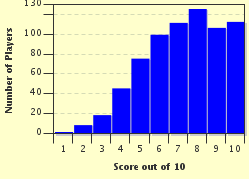Quiz Answer Key and Fun Facts
1. There are quite a few strong women in the Hebrew Bible, but even so, this one stands out. The Book of Judges says that she ruled Israel from underneath a palm tree for four decades, and all through that time the tribes were at peace with each other - not an easy accomplishment. Who was this prophet, poet, and judge?
2. In the Hindu epic of the Ramayana, one woman is clearly special. Sita, the wife of Rama, exemplified loyalty, sacrifice, and quiet courage. Of course, she had some advantages not available to most women: she was the avatar of what goddess of wealth, the wife of the god Vishnu?
3. The Virgin Mary, mother of Jesus Christ, is a major figure in Christianity. Which of these statements about her role in the New Testament is true?
4. The very first convert to Islam - well, after Muhammad - was a woman. Not only that, but she was the woman who in many ways made Islam possible: it was her fortune, accumulated through sound business practice, that supported Muhammad's religious work and bankrolled the young community of believers. Who was she?
5. In the early days of Buddhism, when the Buddha - Siddhārtha Gautama - still walked the earth, women were not permitted to join the Sangha, the monastic community. It took a very special woman, Mahāprajāpatī Gautamī, to persuade the Buddha to allow the ordination of nuns. What was her relationship to the Buddha?
6. The wives of prophets have never had easy lives, but there are compensations. Emma Hale Smith was no doubt reassured in 1830 when her husband, Joseph, had a revelation that mentioned her by name, calling her an "elect lady" and charging her with writing a hymnal. To what religion did Emma Smith devote her time and faith?
7. As modern Wicca grew in popularity, Sybil Leek was one of its most prominent faces, refusing to stay quiet about her faith. At one time she was dubbed the "most famous witch" of her home country, the land of the New Forest and the place where Gardnerian Wicca was born - where was she from?
8. Aimee Semple McPherson was a powerful force in the early twentieth century. A faith healer and evangelist, in person and on the radio, she founded the Foursquare Church in the 1920s - and less than eighty years later, it was spiritual home to eight million people. The Foursquare Church is a part of what broader Christian movement?
9. Over the course of the 20th century, women worldwide have claimed rights and earned honors that were denied their predecessors. Regina Jonas was a trailblazer in faith and feminism. What did she achieve in 1935?
10. In her lifetime, Mother Teresa was recognized around the world as a symbol of holiness. The order she founded - the Missionaries of Charity - were active around the world, but in what country did Mother Teresa herself do most of her work?
Source: Author
CellarDoor
This quiz was reviewed by FunTrivia editor
gtho4 before going online.
Any errors found in FunTrivia content are routinely corrected through our feedback system.

